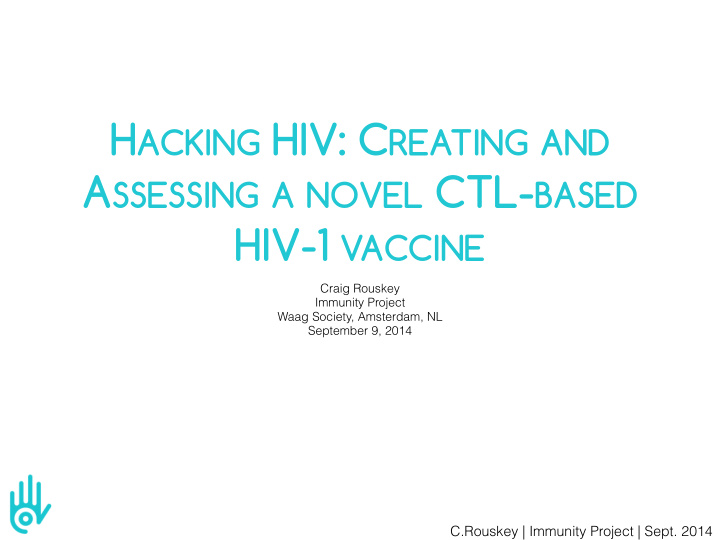



H ACKING HIV: C REATING AND A SSESSING A NOVEL CTL- BASED HIV-1 VACCINE Craig Rouskey Immunity Project Waag Society, Amsterdam, NL September 9, 2014 C.Rouskey | Immunity Project | Sept. 2014
I MMUNITY P ROJECT Immunity Project is a non-profit initiative dedicated to developing an Open-Access HIV vaccine. � We are a non-profit initiative of Flow Pharma, Inc. (Business hack) � C.Rouskey | Immunity Project | Sept. 2014
EPIDEMIOLOGY *Data from WHO, UNAIDS and UNICEF More than 1.1 million people in the United States are living with HIV infection, and almost 1 in 6 (15.8%) are unaware of their infection. C.Rouskey | Immunity Project | Sept. 2014
THE VIRUS C.Rouskey | Immunity Project | Sept. 2014
I MMUNE R ESPONSE TO HIV • Humoral - antibody responses to virus are difficult due to high mutation frequency (old vaccines) • Cellular - the infected body makes CD8+ CTL responses to viral infection, but these cells are down regulated during infection. • Unless you’re a controller ! C.Rouskey | Immunity Project | Sept. 2014
C ONTROLLER • Controllers have the natural ability to prevent advancement of HIV into AIDS. • This is accomplished by the production of T cells with the ability to kill HIV infected cells (Killer T Cells). • All people with HIV produce killer T cells, but in non- controllers , these cells are deleted by HIV-programmed cells. • Different from slow progressors . • We want to turn everyone into controllers! C.Rouskey | Immunity Project | Sept. 2014
THE VACCINE Component Quantity PLGA 98.5% CpG 0.25% 0.05% Peptide (100ng/mL) Mannose 1.25% poly(lactic-co-glycolic acid ) C.Rouskey | Immunity Project | Sept. 2014
H ACKING CTL P EPTIDES • Identification of immunogenic proteins • Identification of peptides that possibly bind to Class I molecules (based on HLA restriction) • Creating databases of peptide binding (syfpeithi.de) • Designing peptides for inclusion in our vaccine C.Rouskey | Immunity Project | Sept. 2014
A2, B57 AND B44 � Positive SL09 KF11 Control Haplotype • Based on these databases, score score Score we chose two peptides specific for class I HLA: SL09 (SLYNTVATL) and KF11 (KAFSPEVIPMF) A2 31 9 31 • We performed a SYFPEITHI analysis to determine the binding probability of 17 HIV-1derived epitopes to class B44 14 20 (228-239, I molecules used in our vimentin) studies. C.Rouskey | Immunity Project | Sept. 2014
IN VITRO ASSAY ( PART I ) C.Rouskey | Immunity Project | Sept. 2014
IN VITRO ASSAY ( PART II ) C.Rouskey | Immunity Project | Sept. 2014
DENDRITIC CELL UPT AKE C.Rouskey | Immunity Project | Sept. 2014
D ENDRITIC CELL MATURATION 100 80 % CD11c+CD86+ 60 40 20 0 CC DY EE FW JeB KT PG PL TB CC DY EE FW JeB KT PG PL TB CD11c+CD86+ 71.3 83.2 69.4 66.9 56.5 30.0 72.3 76.9 56.4 • Flow Cytometry CD11c CD86 APC C.Rouskey | Immunity Project | Sept. 2014
A CTIVATION C.Rouskey | Immunity Project | Sept. 2014
TCR UPREGULATION • On day 15, programmed CD8+ T cells were assessed for their expression of TCR that recognize SL09 in the context of HLA A*02 using A2:SL09 Pentamer (ProImmune). C.Rouskey | Immunity Project | Sept. 2014
IN VITRO ASSAY ( PART II ) C.Rouskey | Immunity Project | Sept. 2014
CTL - MEDIATED KILLING • HIV-infected autologous CD4+ T cells were co-cultured with CD8+ T cells 5:1 (E:T) • CD4+ T cells were assessed for apoptosis and death. • CD8+ T cells were assessed for their ability to produce IFNg in the presence of targets. C.Rouskey | Immunity Project | Sept. 2014
I NTERFERON G AMMA • CD8+ Effector T cells were co-cultured with autologous HIV+ CD4+ T cell targets and assessed for their production of Interferon gamma (IFNg) on day 30. C.Rouskey | Immunity Project | Sept. 2014
P24 SUPPRESSION • p24 ELISA was performed to assess the amount of HIV in the supernatant of CTL assay co-cultures. • A decrease in p24 in tissue culture supernatant means that the T cells are effective at inhibiting HIV. C.Rouskey | Immunity Project | Sept. 2014
F UTURE D IRECTIONS • We are designing pre- clinical experiments in Monkeys. • We are working on clinical trials… • We need a High Throughput Assay (that doesn’t take 30 days to perform). C.Rouskey | Immunity Project | Sept. 2014
D ANK J E W EL ! � � • Dank je wel Pieter van Boheemen en de Waag Society! • Interns: • Co-Founders: • Rohun Patel • Dr. Reid Rubsamen • Naveen Jain • Hannah Hoban • Scientists • COMMUNITY! � • Charlie Herst • Vikram Paranjpe (former Intern) C.Rouskey | Immunity Project | Sept. 2014
T ODAYS E XPERIMENT • Ouchterlony (Double Diffusion) • A test for reactivity of an antigen (protein) and antibody. • Precipitation reaction occurs and determines whether or not the antibody recognizes antigen. • This assay can be used in the field to determine whether or not a patient has come into contact with a virus containing a known antigen. C.Rouskey | Immunity Project | Sept. 2014
P RECIPIT ATION C.Rouskey | Immunity Project | Sept. 2014
P RECIPIT ATION IN TWO DIMENSIONS • Add antigen and antibody to wells and assess precipitation… C.Rouskey | Immunity Project | Sept. 2014
T ODAY ’ S E XPERIMENT (C ONT .) • The Ouchterlony procedure allows us to measure different reactivities . � � � C.Rouskey | Immunity Project | Sept. 2014
P ROCEDURE • Pour plates (5mL of molten 1% agarose in Borate Buffer, pH 7.4) • Allow to cool (5-10min) • Punch holes in each plate (x3) and remove plug. • Add antigen and antibody to each plate. • Incubate overnight at 37C, in humid chamber. C.Rouskey | Immunity Project | Sept. 2014
P LATE S ETUP Tiny Holes � � 10uL of antibody � 10ul of antigen � � � � � Large Holes � 30uL antibody � 30uL antigen C.Rouskey | Immunity Project | Sept. 2014
Recommend
More recommend